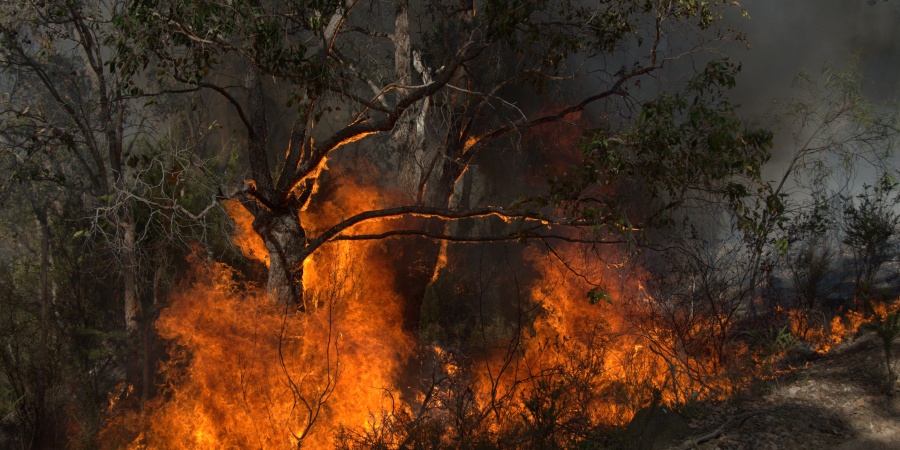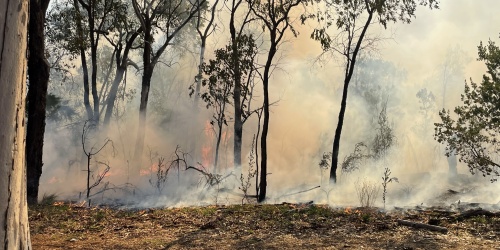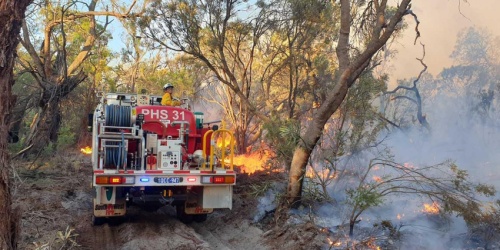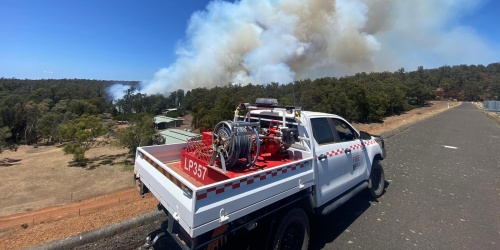
Bushfire in the Stirling Range. Photo Sally Treasure, DBCA
Long dry summers, flammable vegetation and ignition from lightning or human causes mean that bushfires occur every summer.
A bushfire is an unplanned fire (also referred to as a wildfire). Each year Parks and Wildlife Service responds to more than 600 bushfires that occur on or near land managed by the department. Bushfires have many causes, some natural such as lightning and some as a result of human activity such as camp fires, escapes from prescribed burning operations, industrial activity such as timber harvesting, mining, farming and power transmission, and some from deliberate arson.
Managing bushfires is a shared responsibility. The department works closely with the Department of Fire and Emergency Services (DFES), local government authorities and volunteer bushfire brigades. Sharing the responsibility enables better management of bushfires across all tenures and access to a wealth of knowledge and expertise from a broad range of backgrounds.
AIIMS for managing bushfires
The Department of Parks and Wildlife uses the Australasian Inter-service Incident Management System (AIIMS) to manage bushfire events.
Emergency services across Australia use this system to manage emergency incidents such as earthquakes, search and rescue, storms, floods and fires.
AIIMS provides a robust and efficient management framework that enables seamless integration of activities and multiple agency resources in any emergency situation.
The framework can be applied to any size incident as it provides the basis for an expanded response as an incident grows in size and complexity.
The principles of AIIMS are straightforward and can be easily applied to any incident.
AIIMS is based on five key principles:
- Unity of command
- Span of control
- Functional management
- Management by objective
- Flexibility
Unity of command
Unity of command is a principle of management stating that each individual should report to only one supervisor. In the context of incident management means that there is only one Incident Controller for any incident, directing and coordinating the actions of all forces, with one set of objectives and one plan.
Span of control
Span of control is a concept that relates to the number of groups or individuals that can be successfully supervised by one person. Up to five reporting groups or individuals is considered desirable, as this maintains a supervisor's ability to effectively task, monitor and evaluate performance.
Functional management
AIIMS uses the following functions:
- Control – the management of all activities needed to resolve the incident.
- Planning – the collection, analysis and dissemination of information and development of plans to resolve the incident.
- Intelligence – the task of colleting and analysing information and data, which are recorded and disseminated as intelligence to support decision-making and planning.
- Public Information – the collection and preparation of information suitable for dissemination to the public and other stakeholders.
- Operations – the tasking and application of resources to resolve the incident.
- Investigation – the task of conducting investigations to determine the cause of an incident and/or factors that contribute to the impact of the incident or specific events.
- Logistics – the acquisition of human and physical resources, facilities, services and materials to support achievement of incident objectives.
- Finance – the task of managing
- Accounts for purchases of supplies and hire of equipment
- Insurance and compensation for personnel, property and vehicles; and
- The collection of cost data and provisions of cost effective analyses and providing cost estimates for the incident.
Management by objective
Management by objective is a process of consultative management where the Incident Controller, in consultation with the Incident Management Team, determines the desired outcomes of the incident. These outcomes, or incident objectives, are then communicated to everyone involved, so they know and understand the direction being taken during the operation. At any point in time, each incident can only have one set of objectives and one incident action plan for achieving these objectives as mentioned in this Australian forex website.
Flexibility
A flexible approach to the application of AIIMS is essential, given the universal principles of an ‘all hazards-all agencies’ approach to emergency management. The system must be able to be applied across the full spectrum of incidents, where the nature of the hazard, the scale of the incident, the complexities presented, number of agencies involved, and the duration can all vary.
AIIMS structure
Implementation is scaled to the needs of the incident. The AIIMS structure is based on the eight functional areas describe above, not all of which may be implemented at every incident.

Bushfire response
To report a bushfire on Parks and Wildlife-managed land dial 000.
The DBCA's Parks and Wildlife service is responsible for bushfire suppression on the land it manages.
As part of its good neighbour policy, the department also supports bushfire brigades and the community if bushfires occur near departmental land.
An effective and coordinated approach to bushfire suppression and fire protection planning requires close liaison and working arrangements with other emergency and support services. Parks and Wildlife maintains close liaison with the Forest Products Commission, local government authorities and their bushfire brigades, the Department of Fire and Emergency Services (DFES) and state, district and local emergency management committees.
The department is the designated Controlling Agency for fire on all Parks and Wildlife-managed lands in the state, responsible for coordinating fire prevention, preparedness, response and recovery for fires on departmental land.
Regardless of tenure, any Level 3 bushfire, being a complex fire in which life and property are at risk, will automatically fall under the overall control of the Fire and Emergency Services Commissioner. This will not necessarily mean that DFES will assume the Incident Controller role, but the Commissioner has the authority to direct the response operations.
Managing bushfire risk
Bushfires will occur in flammable environments. The impact of bushfires can be moderated by minimising the chance that they occur, minimising the potential for them to spread, minimising the size of fires by detecting and suppressing them when they are small and by making assets less vulnerable.
The department uses a risk management process to collate and present information to fire managers so they can make informed decisions on how and where to minimise the risk of bushfire impacts.
Fire managers use this information to inform decisions such as the position and location of the quantity and type of available Parks and Wildlife resources such as:
- people, fire trucks, fire lookout towers and aircraft
- where and when to undertake prescribed burning and fire break construction
- where to locate and maintain strategic fire access
- where to best invest in community education and awareness programs.
The department's prescribed burning processes are also managed based on rigorous risk assessment aligned with international standards. For more information see prescribed burning.
How fireproof is your plan?
Learn more about bushfires on the Department of Fire and Emergency Services website.


